By now, most of us know that processed sweeteners like high fructose corn syrup or sweet ‘n low are bad for us and that sugar in general, no matter what the source, is something we should limit. Fair enough. But when we have that craving, what’s the best natural sweetener to satisfy that sweet tooth?
There’s much confusion over sweeteners on the market today. What I look for in a sweetener is not whether it has calories or not, but whether it has nutrients. If I’m going to eat something sweet, I want to make sure that it’s minimally refined and that I’m getting some sort of nutritional benefit. The following is a sample of nutrient-rich, natural sweeteners. In no way is this a complete list, but merely a short list of my favorites:
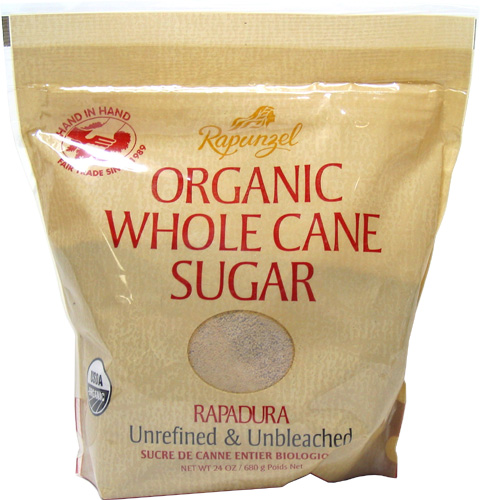 Rapadura (the closest thing you can get to truly raw sugar, next to sucking on the sugar cane itself) is the pure juice pressed from the sugar cane and evaporated at a low heat. It is a whole, naked food and so varies according to location, variety, soil and weather. It has no chemicals or anti-caking agents. This sweetener has minerals, vitamins, and nutrients.
Rapadura (the closest thing you can get to truly raw sugar, next to sucking on the sugar cane itself) is the pure juice pressed from the sugar cane and evaporated at a low heat. It is a whole, naked food and so varies according to location, variety, soil and weather. It has no chemicals or anti-caking agents. This sweetener has minerals, vitamins, and nutrients.
Sucanat is slightly different from Rapadura because the sugar and molasses are separated from each other during the processing, and then recombined. Some argue that the process of separation makes Sucanat not as pure as Rapadura.
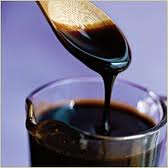
Unsulfured blackstrap molasses is a nutritionally dense food. It’s the final by-product of the sugar refining process, and contains all the nutrients that have been boiled away multiple times from the raw sugar cane. It’s the lowest in sugar and the highest in minerals and other nutrients. It’s an excellent source of iron, potassium, calcium, magnesium, as well as the trace minerals manganese and copper. It’s also high in B-vitamins. Add it to plain yogurt for a different flavor.

Coconut sugar is made from the sap of coconut flower buds. This sweetener is minimally processed and is high in potassium, magnesium, zinc and iron and is a natural source of the vitamins B1, B2, B3, B6 and C. Use it in baking instead of refined sugar as a lower-glycemic and healthier alternative.
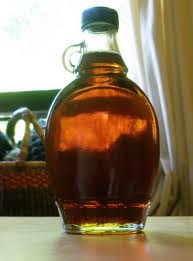 Maple sugar or maple syrup comes from the sap of the maple tree. It’s minimally processed and high in nutrients. You always want to buy 100% pure maple syrup and get the darkest grade you can. The darker the better, that’s why I prefer grade B or C.
Maple sugar or maple syrup comes from the sap of the maple tree. It’s minimally processed and high in nutrients. You always want to buy 100% pure maple syrup and get the darkest grade you can. The darker the better, that’s why I prefer grade B or C.
 Raw, unfiltered honey is considered by many to be one of natures wonder foods. It’s nutrient dense – packed with natural enzymes, phytonutrients, and minerals. It doesn’t spoil, and it’s a natural anti-biotic and anti-fungal. It’s important to keep raw honey raw, which means don’t use it for baking. High heat destroys its delicate enzymes and phytonutrients. Ideally, find raw honey that’s made locally because it contains trace amounts of the pollens in your area, building up your immunity to allergens in your local environment.
Raw, unfiltered honey is considered by many to be one of natures wonder foods. It’s nutrient dense – packed with natural enzymes, phytonutrients, and minerals. It doesn’t spoil, and it’s a natural anti-biotic and anti-fungal. It’s important to keep raw honey raw, which means don’t use it for baking. High heat destroys its delicate enzymes and phytonutrients. Ideally, find raw honey that’s made locally because it contains trace amounts of the pollens in your area, building up your immunity to allergens in your local environment.

Dried dates are whole fruits that have been dried. There are many varieties and they all have a different flavor. They are raw and unprocessed, and have lots of vitamins and nutrients. Simply buy dried dates and soak them in warm water. Then blend the dates with some of the water to make a paste. This paste can be used to sweeten smoothies, baked goods, sauces…you name it.
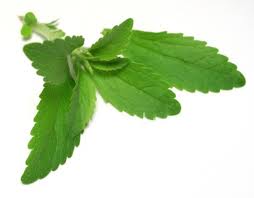 Stevia is a sweet herb that is more than ten times sweeter than most sweeteners. Nutrient amount is questionable and there are no calories. Stevia’s an acquired taste but a good alternative if you want to sweeten a warm drink. There are dried (slightly processed) and liquid (more natural) varieties. Some are more bitter than others, so find the one you like the best if you’re going this route. Just remember, with Stevia, a little goes a long way.
Stevia is a sweet herb that is more than ten times sweeter than most sweeteners. Nutrient amount is questionable and there are no calories. Stevia’s an acquired taste but a good alternative if you want to sweeten a warm drink. There are dried (slightly processed) and liquid (more natural) varieties. Some are more bitter than others, so find the one you like the best if you’re going this route. Just remember, with Stevia, a little goes a long way.
Note the fad sweeteners that aren’t on the above list like Agave Nectar and all those colorful packet sweeteners. These are all sweeteners that are lacking nutrients and in more cases than not, highly processed. Always choose what is naked and nutrient-rich. Most importantly, limit your daily intake of sugar. Let it be a treat instead of the norm.
Here’s a desert recipe that uses dates and some fresh-squeezed orange juice to sweeten it. Whole, natural, sweet, and delish!
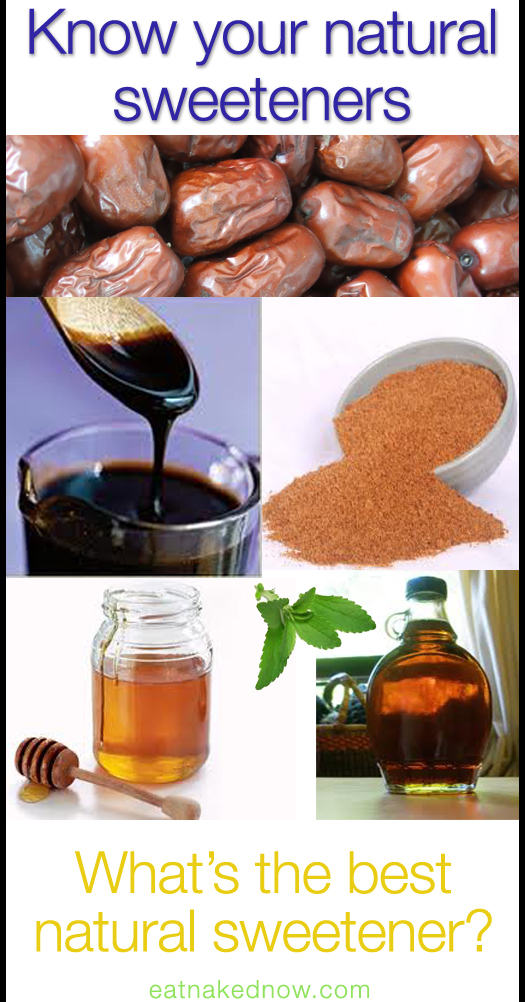
Orange Creamsicle Bites
Yield: 24 balls
Ingredients
- 1/2 cup shredded coconut
- 1 cup rolled oats
- 1 cup date pieces
- 3/4 cup cashew butter
- 1/4 cup raw sunflower seeds
- 2 tablespoons grated orange peel
- 1/3 fresh-squeezed orange juice
Procedure
Place 1/4 cup of the coconut on a plate and set aside.
Place the rolled oats in a heavy-bottomed skillet and toast for a few minutes, stirring constantly. When they begin to turn a darker shade of tan at the edges and emit a toasted aroma, transfer the oats to the bowl of a food processor. Process on high to pulverize them to a fine meal consistency.
Add the remaining 1/4 cup coconut and the dates and process to finely chop them, then add the cashew butter, sunflower seeds, and orange peel. Add the orange juice and process until the ingredients come together to form a homogeneous mass. Add a bit more orange juice, if needed, to get the right thick and well-blended consistency. Don’t add too much juice; you want the mixture to be fairly dry, not moist and mushy.
Use your hands to form the mixture into balls about 1-1/2 inches in diameter, then roll the balls in the reserved shredded coconut. Place on a plate and chill for an hour or so in the freezer before serving.



Hi there, yes I appreciated this article! My intention is to eat food that is good for me not just good to eat and therefore imagine my surprise to learn that agave syrup has no nutritional benefit. Out it goes! Thank you!
My friend recently returned form a trip overseas and brought back four varieties of nakd bars and I loved them. I am always on the look for a healthy and tasty bar that can be packed easily for the times I cannot get something I am willing or wanting to eat.
An excellent product!
Karne
Hi Karne,
Thanks for your comment! Glad that you found the post useful. We actually don’t make the Nakd bar, but I’m glad that you liked them! We’re a totally separate company.
So excited to make gummies… wondering if you can provide brand recommendations or better yet, Amazon links, for stevia, monk fruit sweetener, and coconut sugar… thank you! xoxo
stevia powder
Monkfruit sweetener
coconut sugar
Let us know what you think of the gummy ebook. Thank you!